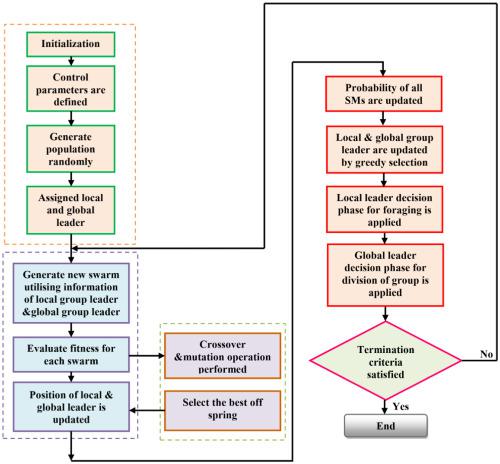当前位置:
X-MOL 学术
›
Int. J. Commun. Syst.
›
论文详情
Our official English website, www.x-mol.net, welcomes your
feedback! (Note: you will need to create a separate account there.)
Genetic spider monkey‐based routing protocol to increase the lifetime of the network and energy management in WSN
International Journal of Communication Systems ( IF 1.7 ) Pub Date : 2020-07-07 , DOI: 10.1002/dac.4525 Jothi Soundaram 1 , Chandrasekar Arumugam 1
International Journal of Communication Systems ( IF 1.7 ) Pub Date : 2020-07-07 , DOI: 10.1002/dac.4525 Jothi Soundaram 1 , Chandrasekar Arumugam 1
Affiliation

|
Wireless sensor networks (WSNs) include large distributed nodes in the sensing field. However, the sensor nodes may die due to energy deficiency as they are situated in a hostile environment. Therefore, an energy‐efficient WSN routing protocol is necessary in order to better accommodate the various environmental conditions. In this paper, we have proposed a new Energy‐Efficient Genetic Spider Monkey‐based Routing Protocol (EGSMRP) to improve the stability and lifetime of sensor nodes. The operation of EGSMRP is classified into two stages: (i) setup phase and (ii) steady‐state phase. In the setup phase, GSMO‐based cluster head selection procedure is done. In this phase, the base station utilizes the GSMO algorithm as a device to generate energy‐efficient clusters. Followed with this, the steady‐state phase solves the load balancing issue by utilizing the intracluster data broadcast and dual‐hop intercluster broadcasting algorithm. Thereby, the proposed EGSMRP protocol has shown the energy‐based opportunistic broadcasting with reduced control overhead. Simulation is performed in various conditions to evaluate the effectiveness of the proposed EGSMRP protocol using different metrics such as throughput, control overhead, energy consumption, end‐to‐end delay, and network lifetime. From the simulation results, it was evident that EGSMRP has achieved a higher performance compared to other traditional approaches such as EBAR, MCTRP, IEEMARP, HMCEER, and EFTETRP.
中文翻译:

基于遗传蜘蛛猴的路由协议可延长WSN中的网络寿命和能源管理
无线传感器网络(WSN)包括传感领域中的大型分布式节点。但是,由于传感器节点位于不利的环境中,可能会由于能量不足而死亡。因此,为了更好地适应各种环境条件,必须使用节能的WSN路由协议。在本文中,我们提出了一种新的基于节能遗传蜘蛛猴的路由协议(EGSMRP),以提高传感器节点的稳定性和寿命。EGSMRP的运行分为两个阶段:(i)设置阶段和(ii)稳态阶段。在设置阶段,完成了基于GSMO的簇头选择过程。在此阶段,基站将GSMO算法用作生成节能集群的设备。随后,稳态阶段通过利用集群内数据广播和双跳集群间广播算法解决了负载平衡问题。从而,提出的EGSMRP协议显示了基于能量的机会广播,并减少了控制开销。在各种条件下进行仿真,以使用吞吐量,控制开销,能耗,端到端延迟和网络寿命等不同指标来评估所提出的EGSMRP协议的有效性。从仿真结果可以看出,与其他传统方法(例如EBAR,MCTRP,IEEMARP,HMCEER和EFTETRP)相比,EGSMRP的性能更高。提议的EGSMRP协议显示了基于能量的机会广播,并减少了控制开销。在不同条件下进行仿真,以使用吞吐量,控制开销,能耗,端到端延迟和网络寿命等不同指标来评估所提出的EGSMRP协议的有效性。从仿真结果可以看出,与其他传统方法(例如EBAR,MCTRP,IEEMARP,HMCEER和EFTETRP)相比,EGSMRP的性能更高。提议的EGSMRP协议显示了基于能量的机会广播,并减少了控制开销。在不同条件下进行仿真,以使用吞吐量,控制开销,能耗,端到端延迟和网络寿命等不同指标来评估所提出的EGSMRP协议的有效性。从仿真结果可以看出,与其他传统方法(例如EBAR,MCTRP,IEEMARP,HMCEER和EFTETRP)相比,EGSMRP的性能更高。
更新日期:2020-07-07
中文翻译:

基于遗传蜘蛛猴的路由协议可延长WSN中的网络寿命和能源管理
无线传感器网络(WSN)包括传感领域中的大型分布式节点。但是,由于传感器节点位于不利的环境中,可能会由于能量不足而死亡。因此,为了更好地适应各种环境条件,必须使用节能的WSN路由协议。在本文中,我们提出了一种新的基于节能遗传蜘蛛猴的路由协议(EGSMRP),以提高传感器节点的稳定性和寿命。EGSMRP的运行分为两个阶段:(i)设置阶段和(ii)稳态阶段。在设置阶段,完成了基于GSMO的簇头选择过程。在此阶段,基站将GSMO算法用作生成节能集群的设备。随后,稳态阶段通过利用集群内数据广播和双跳集群间广播算法解决了负载平衡问题。从而,提出的EGSMRP协议显示了基于能量的机会广播,并减少了控制开销。在各种条件下进行仿真,以使用吞吐量,控制开销,能耗,端到端延迟和网络寿命等不同指标来评估所提出的EGSMRP协议的有效性。从仿真结果可以看出,与其他传统方法(例如EBAR,MCTRP,IEEMARP,HMCEER和EFTETRP)相比,EGSMRP的性能更高。提议的EGSMRP协议显示了基于能量的机会广播,并减少了控制开销。在不同条件下进行仿真,以使用吞吐量,控制开销,能耗,端到端延迟和网络寿命等不同指标来评估所提出的EGSMRP协议的有效性。从仿真结果可以看出,与其他传统方法(例如EBAR,MCTRP,IEEMARP,HMCEER和EFTETRP)相比,EGSMRP的性能更高。提议的EGSMRP协议显示了基于能量的机会广播,并减少了控制开销。在不同条件下进行仿真,以使用吞吐量,控制开销,能耗,端到端延迟和网络寿命等不同指标来评估所提出的EGSMRP协议的有效性。从仿真结果可以看出,与其他传统方法(例如EBAR,MCTRP,IEEMARP,HMCEER和EFTETRP)相比,EGSMRP的性能更高。










































 京公网安备 11010802027423号
京公网安备 11010802027423号